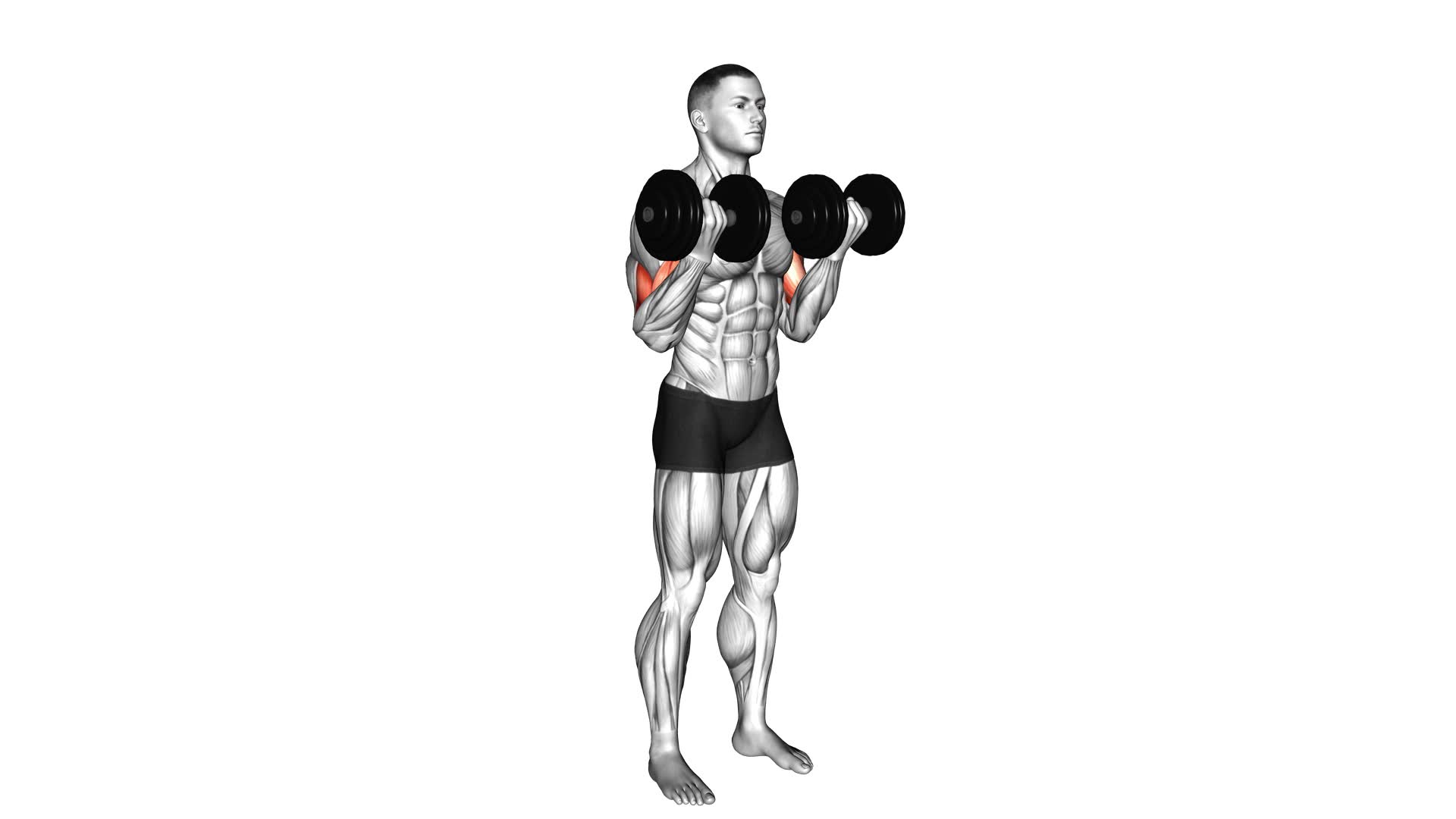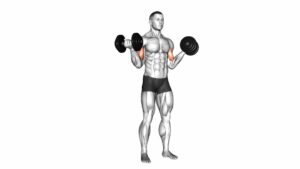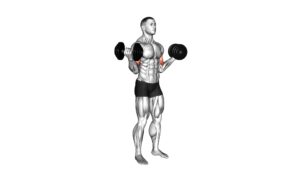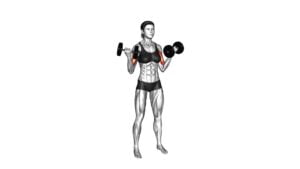Dumbbell Standing Biceps Curl – Video Exercise Guide & Tips

Get ready to strengthen your biceps with the Dumbbell Standing Biceps Curl. This video exercise guide and tips will show you the proper form and help you choose the right weight.
Watch This Exercise Video
Spice up your routine with variations and avoid common mistakes. Maximize the effectiveness of your curls with these helpful tips.
Incorporate biceps curls into your overall fitness routine for well-rounded results.
Let's get those biceps toned and ready to show off!
Key Takeaways
- Keep elbows close to sides
- Avoid swinging the weights
- Start with a lighter weight and gradually increase
- Incorporate variations to spice up your routine
Proper Form for Dumbbell Standing Biceps Curl
To perform the dumbbell standing biceps curl properly, you need to keep your elbows close to your sides and avoid swinging the weights. This exercise is a fundamental movement in weightlifting that specifically targets the biceps and is a great way to build strength in this muscle group.
When performing the dumbbell standing biceps curl, start by standing with your feet shoulder-width apart and a dumbbell in each hand. Keep your back straight and your core engaged throughout the exercise. Begin by fully extending your arms, with your palms facing forward.
As you curl the weights upward, make sure to keep your elbows close to your sides. This will help isolate the biceps and prevent any swinging or momentum from assisting the movement. Slowly lift the weights until your forearms are vertical and your biceps are fully contracted.
Pause at the top of the movement and then slowly lower the weights back down to the starting position, maintaining control throughout the entire range of motion. Repeat for the desired number of repetitions.
Incorporating the dumbbell standing biceps curl into your workout routine can provide numerous benefits, including increased biceps strength and improved overall upper body strength. By following proper form and technique, you can maximize the effectiveness of this exercise and achieve optimal results.
Choosing the Right Weight for Your Biceps Curl
When choosing the right weight for your biceps curl, it's important to consider proper form and avoid using excessive weight. Select a weight that allows you to perform the exercise with proper technique and without compromising your form.
It's recommended to start with a lighter weight and gradually increase the weight as you build strength and improve your biceps curl.
Proper Biceps Curl Weight
Choose a weight for your biceps curl that allows you to perform 8-12 reps with proper form and without sacrificing control.
It's important to find the right weight for your biceps curl to maximize the benefits and avoid injury. Using proper technique during biceps curls helps to target the biceps muscles effectively and prevent strain on other muscles.
By selecting a weight that challenges you within the 8-12 rep range, you can build strength and muscle endurance. This weight range is ideal for promoting muscle growth and increasing overall strength.
It's essential to listen to your body and start with a weight that you can handle comfortably. As you progress, you can gradually increase the weight to continue challenging your muscles and achieving your fitness goals.
Avoiding Excessive Weight
Finding the appropriate weight for your biceps curl is crucial in order to avoid excessive weight and ensure proper form and control while targeting the biceps muscles effectively. By choosing the right weight, you can't only avoid injury but also maximize the benefits of proper form.
Using a weight that's too heavy can strain the muscles and increase the risk of injury, while using a weight that's too light may not provide enough resistance to effectively challenge the muscles. It's important to start with a weight that allows you to perform the exercise with proper technique and control.
As you become stronger, you can gradually increase the weight to continue challenging your muscles and making progress. Making the right weight selection is essential for a safe and effective biceps curl workout.
Gradual Weight Progression
To ensure a safe and effective biceps curl workout, gradually increase the weight as you strengthen your muscles, allowing for continued progression and optimal results.
A gradual weight increase is essential to challenge your muscles and promote growth over time. Start with a weight that you can comfortably lift for 8-12 repetitions with proper form.
As you become stronger, gradually add weight in small increments, such as 2-5 pounds, to continue challenging your muscles. Progression techniques, such as adding an extra set or increasing the number of repetitions, can also be incorporated to further stimulate muscle growth.
Remember to listen to your body and only increase the weight when you feel ready. By gradually increasing the weight, you can ensure that your biceps curl workout remains effective and safe while achieving your desired results.
Variations to Spice up Your Biceps Curl Routine
Try incorporating different variations into your biceps curl routine to add some excitement and challenge to your workouts. By spicing up your biceps curl routine with variations, you can target different muscles, prevent plateau, and enhance overall strength and muscle development.
One variation you can try is the hammer curl. Instead of holding the dumbbells with your palms facing up, you hold them with your palms facing each other. This variation targets the brachialis, a muscle located underneath the biceps, providing a fuller look to your arms.
Another variation is the incline biceps curl. By performing the biceps curl on an incline bench, you can increase the range of motion and engage the biceps from a different angle. This variation not only stimulates muscle growth but also helps improve overall arm strength.
To challenge yourself further, you can incorporate the concentration curl. This exercise involves sitting on a bench and placing your elbow against your inner thigh, curling the dumbbell up towards your shoulder. The concentration curl isolates the biceps, allowing for a more intense contraction and greater muscle activation.
Incorporating these variations into your biceps curl routine can help you break through plateaus and achieve better results. Remember to always use proper form and gradually increase the weight as you get stronger. Keep your workouts exciting and challenging by trying different variations and watch your biceps grow stronger and more defined.
Common Mistakes to Avoid During Biceps Curls
When performing biceps curls, it's important to avoid common mistakes that can lead to incorrect form and potential dangers.
Incorrect form, such as using momentum or swinging the weights, not only reduces the effectiveness of the exercise but also increases the risk of injury.
Additionally, overtraining the biceps by performing too many sets or repetitions can hinder progress and lead to muscle imbalances.
Incorrect Form Dangers
Avoiding incorrect form dangers during biceps curls is essential for maximizing your gains and preventing injury. Engaging in biceps curls with incorrect form can expose you to various dangers and increase the risk of overtraining.
One common mistake to avoid is using momentum to lift the weights. Swinging the dumbbells not only reduces the effectiveness of the exercise but also puts unnecessary strain on your joints and muscles.
Another mistake is lifting the weights too quickly, which can lead to improper muscle activation and potential injury. Additionally, avoid excessive wrist flexion or extension, as this can strain the tendons and ligaments in your wrists.
Remember to maintain proper posture and control throughout the exercise to ensure optimal results and minimize the risk of injury.
Overtraining Risk
To prevent overtraining during biceps curls, be mindful of the following common mistakes.
- Overtraining risks can occur when you push yourself too hard or don't give your muscles enough time to recover.
One mistake to avoid is using too much weight. While it may seem tempting to go heavy, using weights that are too heavy can lead to muscle strain and increase the risk of overtraining.
Another mistake is performing too many sets and repetitions. It's important to find the right balance between challenging your muscles and allowing them to rest.
Lastly, not incorporating rest days into your workout routine can also contribute to overtraining. Rest days are essential for muscle recovery and preventing overuse injuries.
Tips for Maximizing the Effectiveness of Your Biceps Curls
To maximize the effectiveness of your biceps curls, grip the dumbbells firmly and maintain proper form throughout the exercise. By doing so, you can maximize gains and prevent muscle imbalances. When gripping the dumbbells, ensure that your palms are facing forward and your wrists are straight. This will help target the biceps muscles more effectively. Throughout the exercise, keep your elbows close to your sides and avoid swinging or using momentum to lift the weights. This will ensure that the biceps muscles are doing the majority of the work.
Additionally, focus on a slow and controlled movement, both on the way up and on the way down. This will engage the muscle fibers more effectively and lead to better results. Remember to breathe naturally and avoid holding your breath during the exercise. By incorporating these tips into your biceps curls, you can maximize the effectiveness of this exercise and achieve better results.
Now, let's discuss how to incorporate biceps curls into your overall fitness routine.
Incorporating Biceps Curls Into Your Overall Fitness Routine
Now let's delve into how you can incorporate biceps curls into your overall fitness routine to maximize their effectiveness.
Biceps curls are a popular exercise for building strength and definition in the upper arms. They're especially effective for targeting the biceps muscles, which are responsible for flexing the elbow joint.
One way to incorporate biceps curls into your fitness routine is to include them in your weightlifting workouts. Biceps curls can be performed as a standalone exercise or as part of a larger upper body workout. By including biceps curls in your weightlifting routine, you can specifically target and strengthen the biceps muscles.
Another way to incorporate biceps curls is by incorporating them into high-intensity interval training (HIIT) workouts. HIIT workouts are known for their efficiency and effectiveness in burning calories and improving cardiovascular fitness. By adding biceps curls into your HIIT routine, you can increase the intensity of your workout and engage multiple muscle groups simultaneously.
Incorporating biceps curls into your overall fitness routine can provide numerous benefits. Not only do they target and strengthen the biceps muscles, but they also contribute to overall upper body strength and muscular balance. Whether you choose to include them in your weightlifting routine or HIIT workouts, biceps curls are a versatile exercise that can be modified to suit your fitness goals and preferences.
Frequently Asked Questions
How Many Sets and Repetitions Should I Do for the Dumbbell Standing Biceps Curl Exercise?
To get the most out of the dumbbell standing biceps curl exercise, it's important to know how many sets and repetitions to do. The ideal number of sets and reps will vary depending on your fitness level and goals.
Generally, it's recommended to start with 3 sets of 8-12 reps. This allows you to challenge your muscles while maintaining proper form.
Remember to warm up before and cool down after each session to prevent injury and maximize results.
Can I Do the Dumbbell Standing Biceps Curl Exercise With a Barbell Instead of Dumbbells?
Yes, you can definitely do the dumbbell standing biceps curl exercise with a barbell instead of dumbbells.
Using a barbell for biceps curls offers some benefits like increased stability and the ability to lift heavier weights.
It also allows for a wider grip, which targets different areas of your biceps.
How Long Should I Rest Between Sets When Performing the Dumbbell Standing Biceps Curl Exercise?
When performing the dumbbell standing biceps curl exercise, it's important to consider your rest intervals for optimal muscle recovery. Resting between sets allows your muscles to recover and replenish energy before the next set.
The length of your rest intervals will vary depending on your fitness level and goals. It's generally recommended to rest for 30-90 seconds between sets to allow for adequate recovery without losing momentum in your workout.
Should I Flex My Wrists During the Dumbbell Standing Biceps Curl Exercise?
When performing the dumbbell standing biceps curl exercise, it's important to consider whether or not to flex your wrists.
Flexing your wrists can provide additional benefits, such as engaging the forearms and increasing the intensity of the exercise.
However, it also depends on your personal preference and comfort level.
Can I Perform the Dumbbell Standing Biceps Curl Exercise Using Resistance Bands Instead of Dumbbells?
Yes, you can perform the dumbbell standing biceps curl exercise using resistance bands instead of dumbbells.
Using resistance bands for biceps curls offers several benefits. They provide constant tension throughout the movement, helping to strengthen and tone your biceps.
Resistance bands are also portable and versatile, allowing you to easily adjust the level of resistance.
Conclusion
In conclusion, the dumbbell standing biceps curl is a highly effective exercise for strengthening and toning your biceps. By following proper form, choosing the right weight, and incorporating variations into your routine, you can maximize the effectiveness of this exercise.
Remember to avoid common mistakes and consider incorporating biceps curls into your overall fitness routine for well-rounded arm strength and definition.

Author
Years ago, the spark of my life’s passion ignited in my mind the moment I stepped into the local gym for the first time. The inaugural bead of perspiration, the initial endeavor, the very first surge of endorphins, and a sense of pride that washed over me post-workout marked the beginning of my deep-seated interest in strength sports, fitness, and sports nutrition. This very curiosity blossomed rapidly into a profound fascination, propelling me to earn a Master’s degree in Physical Education from the Academy of Physical Education in Krakow, followed by a Sports Manager diploma from the Jagiellonian University. My journey of growth led me to gain more specialized qualifications, such as being a certified personal trainer with a focus on sports dietetics, a lifeguard, and an instructor for wellness and corrective gymnastics. Theoretical knowledge paired seamlessly with practical experience, reinforcing my belief that the transformation of individuals under my guidance was also a reflection of my personal growth. This belief holds true even today. Each day, I strive to push the boundaries and explore new realms. These realms gently elevate me to greater heights. The unique combination of passion for my field and the continuous quest for growth fuels my drive to break new ground.







